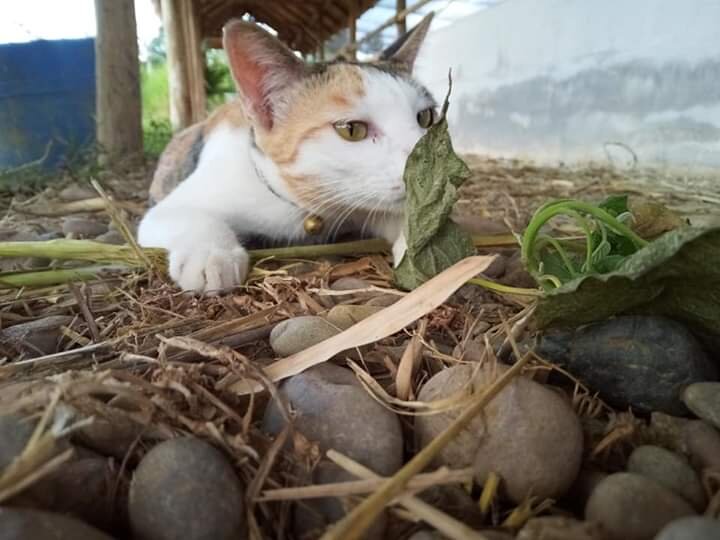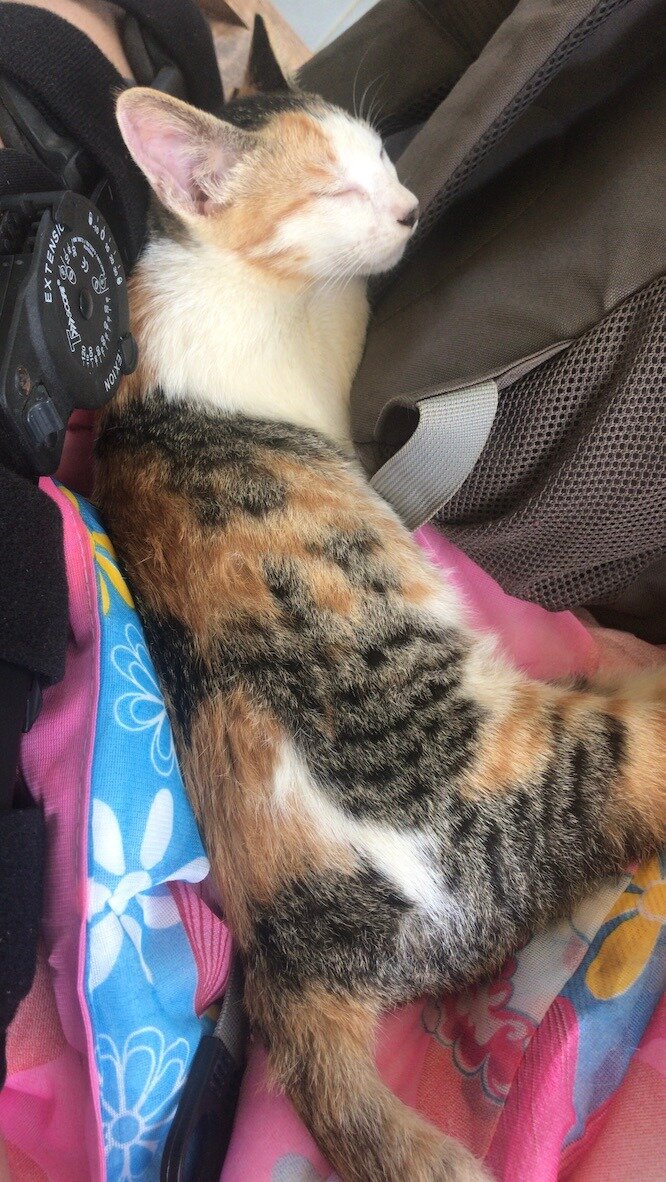
Blog
The Laos Buffalo Dairy Story Part 4 - A Virtual Tour of the Mini Farm
Over the previous three blog posts, we have shared with you the story of how we got to where we are today! I think you will agree it has been quite an adventure and, indeed, continues to be so. So today, we thought it made sense to take you on a virtual tour of our mini-farm. We would much rather be able to share the tour in person however, unless you are already in Laos (in which case come and say Hi!), then this is definitely the next best thing :0)
Over the previous three blog posts, we have shared with you the story of how we got to where we are today! I think you will agree it has been quite an adventure and, indeed, continues to be so. So today, we thought it made sense to take you on a virtual tour of our mini-farm. We would much rather be able to share the tour in person however, unless you are already in Laos (in which case come and say Hi!), then this is definitely the next best thing :0)
Welcome to the Laos Buffalo Dairy! We are going to start by heading to the café to wash our hands before we visit the animals. On the way, one of the first things you might notice is that there are other animals than buffalo on the farm. That’s because when we started building the dairy we decided that there were some other projects we could include in the design. The mini-farm was built as a space for farmer training as well as a kid friendly space for families on holiday to come and discover.
When we first arrived, Luang Prabang didn’t have many activities for kids to do. And, we all know that if you go on a family holiday and your kids don’t have fun, then neither do you! So, the mini-farm is a hang out where kids, of all ages, can get up close and personal with animals.
We also knew, after some observation and research, that there were better methods of raising animals in Laos, but we, as foreigners, couldn’t just come in and say, “Hey, you’re doing it all wrong! Change everything you’re doing.” The mini-farm serves as a practical “seeing is believing” demonstration that we share with farmers. Everything we built uses local materials, so farmers can have a look and see that they can reproduce the same for themselves. While some of our structures are bigger or grander than necessary because it’s a tourist stop, farmers can see how to scale it for their own needs. Seeing it work, takes the fear out for the farmer, who will then be more inclined to try it out.
This Little Piggy
For example, our pig pen is situated near the main office and the café. No one in their right mind would do that unless they could be certain the method we applied worked! No-one wants to eat or work near a smelly pig pen! Our pen has been dug down to a significant depth, and the pen is filled in with rice bran husk or Job’s Tears. The husk is a byproduct that the farmers usually burn, which in turn is harmful to the environment. The rice bran husk stays in the pen for 3-4 months, and helps to absorb the smells. Our team removes the solid waste daily, which also helps to keep the smell down. The pigs are constantly digging in the husk, which helps turn it over and create a nice organic material - I do ask the pigs as they dig to find me truffles, but, so far, no luck - ha ha! At the end of the 3-4 months, we clear out the husk from the pen and put it on our crops as an organic fertilizer, which saves us money.
Bunny Palace
The next stop is to the rollicking rabbits. The rabbits will come rushing over to say hello and see what you might be about to feed them! Farmers in Laos do breed rabbits for food, but the rabbits are mostly very skinny and there aren’t many of them. Our bunny palace is a good way to show farmers how to breed and look after rabbits. In Laos, most farmers raise their rabbits in cages on the ground, leaving the rabbits with no ability to get off the wet ground when it rains (and Laos has a rainy season!). Rabbits are actually very delicate and cannot tolerate a lot of heat or wetness. The bunny palace is set up on stilts so the rabbits can escape the wet ground when needed. There’s also a concrete pad underneath the hutches which helps wick away some extra water and, in the summer, it provides a cool spot for them to relax in the shade.
Rabbits are a great resource for people looking for a good, fast growing source of protein. Rabbits can get pregnant for the first time at around six months of age. Rabbits have a divided uterus, so they can have two separate pregnancies going on at the same time and they are pregnant for about one month - who’d have thought! Also, did you know that a litter of rabbits is called a ‘fluffle’? Isn’t that cute! So, in a country like Laos where there are many poor and undernourished people, breeding rabbits can be a good option as a source of protein. A rabbit only costs about $12, as opposed to a buffalo that costs about $1,200, and of course rabbits reproduce much faster.
Training Room
The next stop is the training room/library. At the farm, we offer free English classes to any of our team who are interested to learn. When we first started the farm, there was no one out here who taught English, and our team wanted to go back to town for lessons. But that didn’t work for us. It took them an hour to travel each way, and then an hour for class, and class wouldn’t start before 9am at the earliest. So, that was three hours out of the work day when the animals needed tending. The solution; we started English lessons on the farm. And we currently offer them four times a week, as opposed to just once a week in town. In the beginning we had volunteers come and teach for us. Our very first English teaching volunteer, Peter, set up the initial lesson plans for us and we had a few volunteers who came after who tried to keep the lesson plans going, but eventually we saw that they all reverted back to, “Hello, my name is... What’s your name?” You can read more about our English classes by clicking here.
Because of our affiliation with the government and our work with the Northern Agricultural & Forestry College and Souphanouvong University, we managed to arrange for English at the farm to expand to the local community. Since no one out this far taught English we had a very happy community. We were lucky enough to have a conversation one day with GVI – a group in town that teaches English - mostly to monks, but to others as well – that led to a collaboration to teach at the farm. GVI would come out with their volunteers and teach a few days a week and continue the lesson plans going forward from where our team was up to. It ended up being a win-win.
Our training room has recently been transformed into an after-school library for the kids. In December 2019, we received a donation to help make this transformation happen and the high school kids from VIS in Vientiane came to help set it up. You can read more about our local Lao teachers and community English lessons by clicking here.
Milking Area
The milking area is where our visitors can have a go at milking a buffalo! After the milking, we meet some of the mums and calves and get up close and personal for our selfie pictures. Not sure who enjoys this more, the visitors or the buffalo! Our buffalo love to be cuddled and after the cuddles, they expect a bath. Our intrepid visitors can get out the hose and scrub brushes and try to make funky hair styles on the Murrah cross breeds, as they have longer hair, perfect for styling. But even if you just want to stroke the buffalo with a scrub brush, they will happily stand still and take in all the attention. We call it buffalo gushiness!
Buffalo Feeding
After bathing the buffalo, walk over to the outside of the pen and feed the buffalo some Napier grass. Each buffalo eats at least 10% of its body weight a day, which amounts to about 30kg of food a day. Napier grass is extremely nutritious for the buffalo, and is also drought resistant, handy in a country like Laos where there is a long dry season. And the best part? It’s a local grass which can be found just about anywhere in Laos by the sides of the road.
Buffalo Cuties
The next pen is the cutest, as here are the buffalo calves! The calves you see here are almost always full blood Murrah babies. Once the calves reach the four-month mark, they can be fully vaccinated, which means they can come to the mini-farm and play with the guests! These buffalo adore being out here because although they are fully weaned and no longer need milk, most of our guests choose to give them a baby bottle with buffalo milk in it – they don’t strictly need it, but they LOVEit!
The Dairy - a quick peep
Step away from the calves (if you can leave all that buffalo cuteness behind) and have a peep over the fence at the working side of the farm. We can’t let you go on this side of the farm, because to be frank, we don’t know where you have been! Seriously, since we don’t own the animals we have to be careful not to let any diseases on site that may harm the animals. From here you can see the milking area and the sheds that shelter the buffalo.
If you look between some of the buildings, you can also see the tall Napier grass growing out the back. We currently have almost 17 hectares of grass, which is enough to feed 100 buffalo for a year.
As we walk back to the café, we pass our cow and calf on the right and our newest additions, the goats! Both of these play a role in the expansion of our nutrition program. You can read more about our nutrition program here And our cows here.
And now we are back at the cafe, it is time for you to enjoy some of our delicious buffalo dairy inspired treats.
HAVE YOU SEEN OUR SOCIAL MEDIA THIS WEEK?
If not, pop on over to facebook/laosbuffalodairy or instagram/laosbuffalodairy to see what we have been up to!
Lily's Story - Our amazing, cuddly cutie pie
If you have been to the farm or you follow us on social media, you know that we have two cats called Cracker and Lily. Today’s story is all about Lily so, don’t tell Cracker or he will get jealous 😊.
Lily was a rescue(d) cat! It all started back in June 2018, during the rainy season when after some serious rains and flooding, we were on our way home from the farm in the tuk tuk one day when we saw something in the middle of the road. Khamla swerved around “it” and we realized it was a little kitten. We pulled up to a stop, with Susie saying, “No, no no!” the whole time as we already had quite a few cats a home. As the tuk tuk stopped and we got out to go at least move her off the road, she looked at us over her shoulder and turned to come running at us. As I reached down to pick her up, she cuddled up onto my shoulder and purred like crazy.
We walked around the edge of the road and looked to see if we could find a mother cat nearby or other kittens thinking maybe she had just strayed away from them, but we found nothing. She was such a tiny little thing that we couldn’t in good conscious just leave her there. So, we took her with us. I stuffed her inside my coat to keep her warm, as it was quite chilly from the rain, and she cuddled right in. She must have known that her life was about to change for a better that she could never imagine.
Lily came home with us that night and got a bath – she desperately needed it as she was very dirty. She was fed some milk and food, and came to bed with me. From her size, we estimated she was only about 7 weeks old. Way too little to be away from her mother, so I guess we were mum now.


We luckily had Nicola, a vet, who was here in Laos working with Sydney University on a project, coming to the farm in the next few days, so we asked if she could have a look a Lily and make sure she looked ok and also confirm our thoughts on her age. Nicola confirmed her age for us as approximately 7 weeks old and told us that her fat little belly was probably full of worms. Not an issue! A worming tablet was given and all would be right with the world.
At the time, we had another cat at the farm as well – Kiara. Kiara was also a rescue cat, but she had been found in our chicken coop (also at about 7 weeks old). Kiara, now being about a year old, decided to take on the roll of mother cat and started to teach Lily how to act.
Lily flourished under the tutelage of Kiara and became cat extraordinaire. She learned how to hunt and play and be a smooch for affection.
Fast forward to now, and every morning when we arrive at the farm, Lily comes for her morning snuggles and purry cuddles. She helps to keep the mouse, rat and small snake population on the farm down to a minimum. And she walks the farm checking on the other animals to make sure all is good. On occasion you can find Lily following along with the guests on a tour. If we ever leave Laos, she has most certainly earned herself a passport out with us.
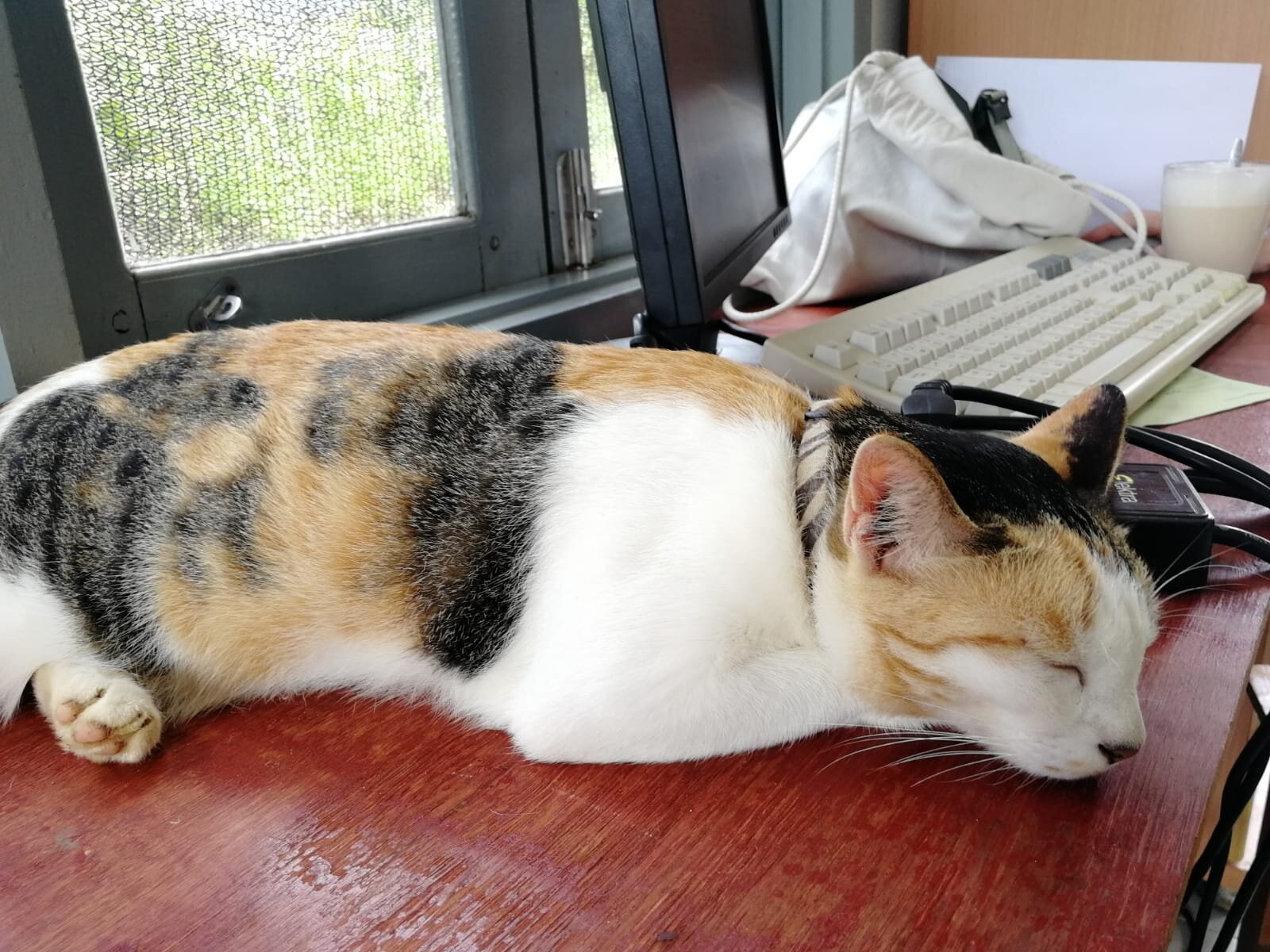
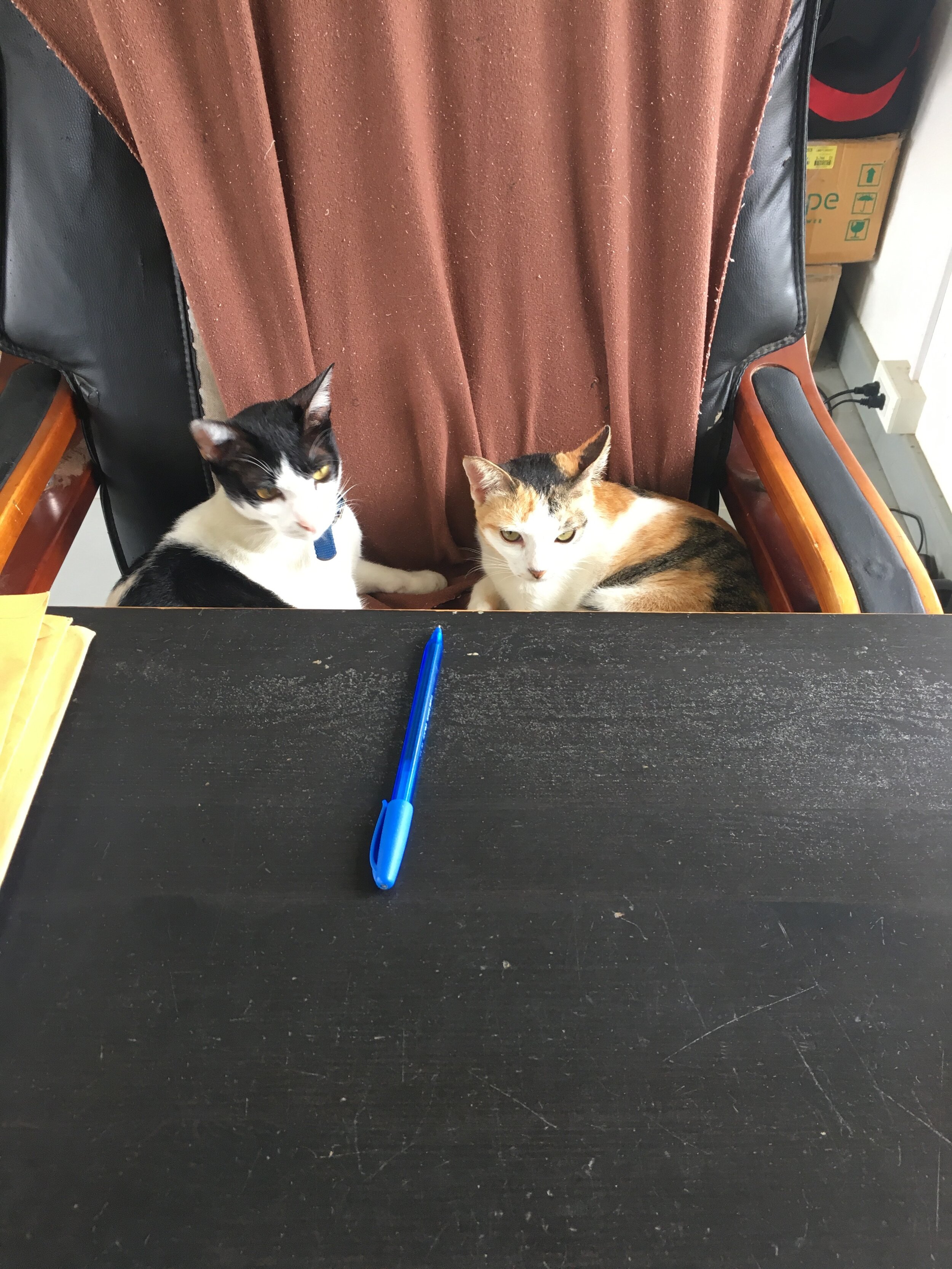
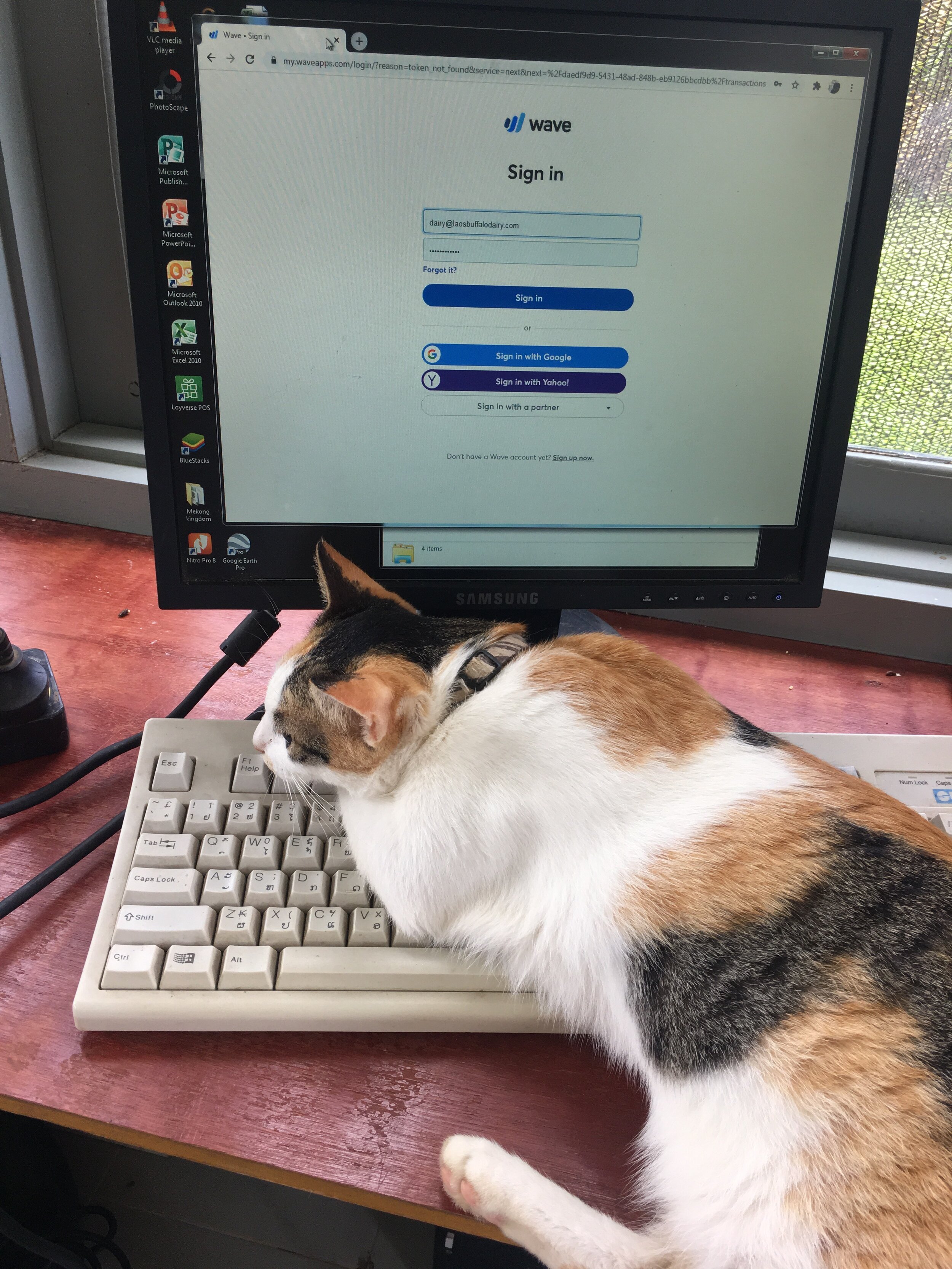
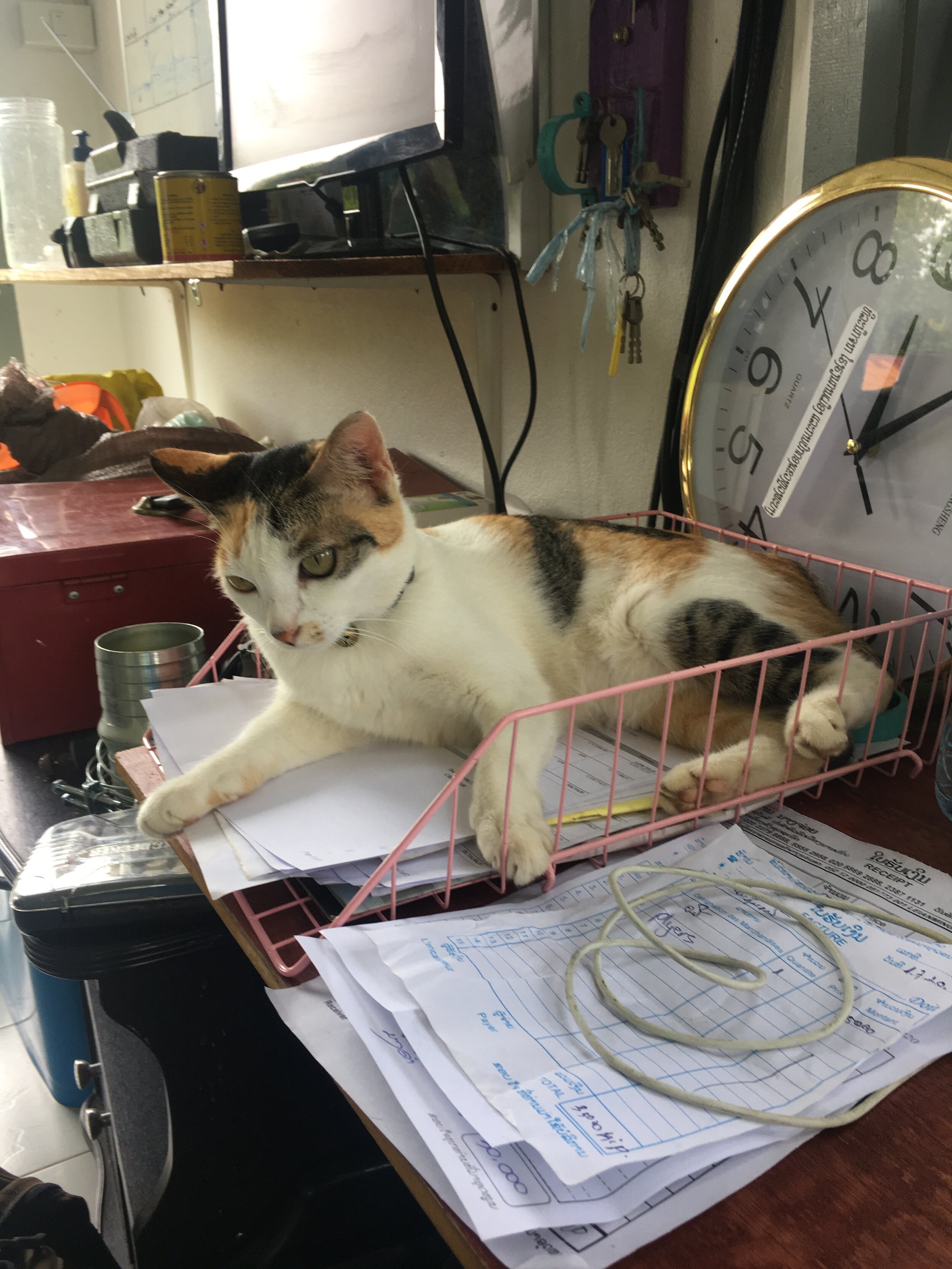
As you can see from some of the pictures, Lily’s favorite place to hang out in is in the office. Lately, with the lack of tourists coming to pay attention to her and Cracker, she has taken to “getting in the way”. Lily decides when the work day is done, but placing herself squarely in the file box or across the keyboard as I try and work.
Lily and Cracker are making do with seeking attention from us, but they’d really like to see you come back to play with them.
TOURISM IN NEED
COVID-19 has badly affected tourism and visits to the farm. In order to mitigate some of the effects of the loss of income this has meant for the dairy, we have teamed up with the Tourism in Need initiative that supports responsible tourism organizations affected by the pandemic. Through this initiative, travelers can support the dairy through the Give Today, Go Tomorrow fundraising scheme. Click here to find out more and to make a contribution to help us to pay farmers and team members, and continue to train farmers and work on our nutrition program.
HAVE YOU SEEN OUR SOCIAL MEDIA THIS WEEK?
If not, pop on over to facebook/laosbuffalodairy or instagram/laosbuffalodairy to see what we have been up to!
Coming to Luang Prabang sometime soon? Need suggestions on what to do? Pop on over to our Suggested Itineraries page and make a plan.









